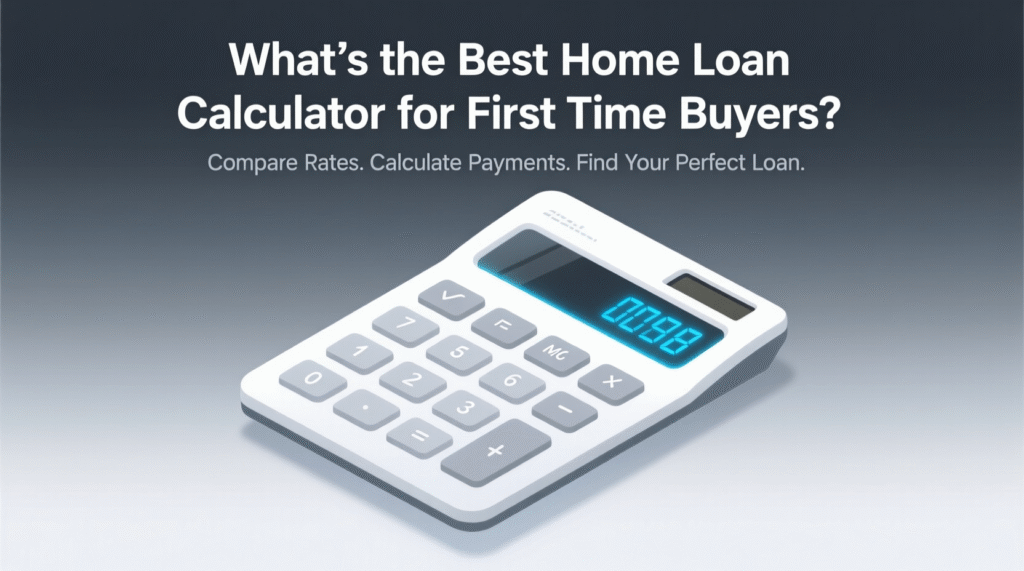
When you’re a first-time home buyer, choosing the right home loan calculator is a crucial first step. The best tool isn’t just about getting a single monthly payment number; it’s about understanding the entire financial picture of your mortgage. A great calculator for a first-timer should be a comprehensive financial planning tool that helps you answer questions like, “How much house can I afford?” and “How can I pay off my mortgage faster?”
What Makes a Home Loan Calculator Great for First-Time Buyers?
The best calculator offers a suite of integrated tools, not just one function. Look for a tool that includes the following:
- Affordability Calculator: This helps you figure out your maximum budget before you even start house hunting. It uses your income, monthly debts, and down payment savings to determine a realistic purchase price you can afford. This prevents you from falling in love with a home outside your price range.
- PITI Breakdown: A good calculator will show you a full breakdown of your monthly payment, including Principal, Interest, Taxes, and Insurance (PITI). It’s essential to see these costs together to get an accurate total. Many new buyers forget to factor in property taxes and insurance, which can add hundreds of dollars to a monthly payment.
- Amortization Schedule: This is a must-have feature. An amortization schedule is a detailed table showing every single payment over the life of your loan. It clearly separates how much of each payment goes toward the principal (the loan balance) and how much goes to interest. This is a powerful visual that shows you exactly how your loan balance decreases over time.
- Payoff & Extra Payments Calculator: This tool shows you how making extra payments can dramatically shorten your loan term and save you a significant amount in interest. For example, you can see how adding just $50 a month to your payment could cut years off a 30-year mortgage.
Practical Example: How to Use a Home Loan Calculator
Let’s say you have an annual gross income of $85,000, monthly debts of $400, and a down payment of $40,000. You are considering a $300,000 home with a 30-year fixed-rate mortgage at 6.5%.
Input:
- Home Price: $300,000
- Down Payment: $40,000
- Loan Amount: $260,000
- Interest Rate: 6.5%
- Loan Term: 30 years
- Estimated Annual Property Taxes: $3,000
- Estimated Annual Home Insurance: $1,500
Output:
- Principal & Interest: $1,643
- Property Taxes (monthly): $250
- Home Insurance (monthly): $125
- Total Monthly Payment (PITI): $2,018
This number gives you a clear and accurate estimate of what your monthly housing cost will be. You can then use the amortization schedule to see that over the life of the loan, you’ll pay nearly $330,000 in interest alone—more than the original loan amount.
Frequently Asked Questions
- How do I calculate a home loan payment?
To calculate a home loan payment, you need the loan amount, interest rate, and loan term. Most calculators also ask for property taxes and homeowner’s insurance to give you a full monthly payment amount (PITI), which is more accurate.
- What is the 28/36 rule in home buying?
The 28/36 rule is a guideline lenders use. Your total monthly housing payment (PITI) shouldn’t exceed 28% of your gross monthly income, and your total debt payments (including your mortgage) shouldn’t exceed 36% of your gross monthly income.
- Why is it important to use a home loan calculator?
Using a calculator helps you understand your budget and the long-term cost of a loan. It allows you to model different scenarios, such as the impact of a larger down payment or a shorter loan term, which can save you a significant amount of money.
- Can I get a home loan with bad credit?
It is possible to get a home loan with bad credit, but it will likely come with a higher interest rate and stricter terms. You may need to explore loan programs specifically designed for borrowers with lower credit scores.
- How much do I need for a down payment?
While a 20% down payment helps you avoid Private Mortgage Insurance (PMI), many first-time buyer programs allow you to put down as little as 3% or 5%. A larger down payment, however, will result in a smaller loan and a lower monthly payment.
Fredrick is the creator behind houseloancalculatormalaysia.online, dedicated to helping Malaysians easily understand and calculate their home loan payments. With a focus on accuracy and simplicity, Fredrick develops reliable tools and clear guides to empower users to make informed financial decisions. His goal is to provide trustworthy, user-friendly resources that save time and reduce confusion in the complex world of home loans.
